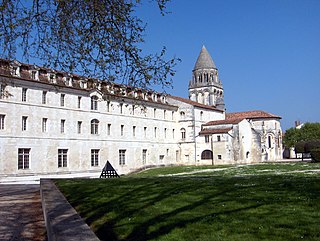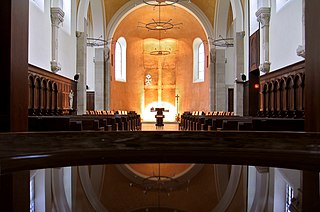
Aisne is a French department in the Hauts-de-France region of northern France. It is named after the river Aisne. In 2020, it had a population of 529,374.

Montreuil Abbey, or Montreuil-les-Dames, was a Cistercian nunnery in the Diocese of Laon, France, located at first at Montreuil-en-Thiérache until the 17th century and afterwards in Laon, where it was known as Montreuil-sous-Laon.

Cistercian nuns are female members of the Cistercian Order, a religious order of the Catholic Church.
Faremoutiers Abbey was an important Merovingian Benedictine nunnery in the present Seine-et-Marne department of France. It formed an important link between the Merovingian Frankish Empire and the southern Anglo-Saxon kingdoms of Kent and East Anglia.

Chimay Abbey is an abbey in Wallonia in the city of Chimay, Hainaut, Belgium.

The Abbaye aux Dames was the first Benedictine nunnery in Saintes in Charente-Maritime in France. The abbey was founded in 1047 by Geoffrey II, Count of Anjou, and his wife Agnes. Agnes later retired to the nunnery and died there.

Jouarre Abbey is a Benedictine abbey in Jouarre in the département of Seine-et-Marne.

Vauclair Abbey otherwise Vauclerc Abbey was a Cistercian monastery founded in 1134 by Saint Bernard of Clairvaux at the request of Barthélemy de Jur, bishop of Laon. It was located in what is now the commune of Bouconville-Vauclair, department of Aisne, France.

Maubuisson Abbey is a Cistercian nunnery at Saint-Ouen-l'Aumône, in the Val-d'Oise department of France. It was founded in A.D. 1236 by Blanche of Castile, Queen of France, who may have been buried there in 1252. The site is now within the north-western suburbs of Paris. The surviving buildings are listed as a monument historique.

Igny Abbey or Val d'Igny Abbey is a Cistercian abbey located in Arcis-le-Ponsart, Marne, France. It was founded in 1128 for Cistercian monks, dissolved in 1791 during the French Revolution, re-established in 1876 for Trappist monks, destroyed in 1918, reopened in 1929 for Trappist nuns and modernised in 2008–12 to accommodate three or four pre-existing communities.

Valognes Abbey is a 17th-century Benedictine abbey located in Valognes, France.

The Abbey of Notre Dame aux Nonnains, also called the Royal Abbey of Our Lady of Troyes, was a convent founded before the 7th century in Troyes, France. The non-cloistered canonesses became wealthy and powerful in the Middle Ages. In 1266–68 they defied the pope and used force to delay construction of the collegiate Church of St Urbain. They were excommunicated as a result. Later the abbey adopted a strictly cloistered rule and the nuns became impoverished. Work started on building a new convent in 1778 but was only partially completed before the French Revolution (1789–99). The abbey was closed in 1792 and the church was demolished. The convent became the seat of the prefecture of Aube.
The Abbaye de la Déserte or Abbaye Notre-Dame de la Déserte was a nunnery in Lyon, France. Founded in 1303 by Louis de Villars, Archbishop of Lyon, and Blanche de Chalon, who was also the first abbess, it housed the Poor Clares from 1304 till 1503, and then Benedictine nuns from 1503 to the French Revolution, when it was dissolved. It was demolished in 1814.
Origny Abbey was a Benedictine nunnery located in Origny-Sainte-Benoite, Aisne, France.

The Abbey of St Caesarius, at first called the abbey or monastery of St John, was a nunnery in the city of Arles in the south-eastern corner of the rampart. It was founded in 512 AD by Saint Caesarius of Arles, after whom it is now named. The abbey was suppressed in the French Revolution. Those that remained of the buildings were later used as a hospice; they are now adandoned.
Antoinette Desmoulins, better known by her monastic name Sister Aldegonde Desmoulins, was a French Benedictine nun of the Abbaye de la Paix Notre-Dame de Liège.













